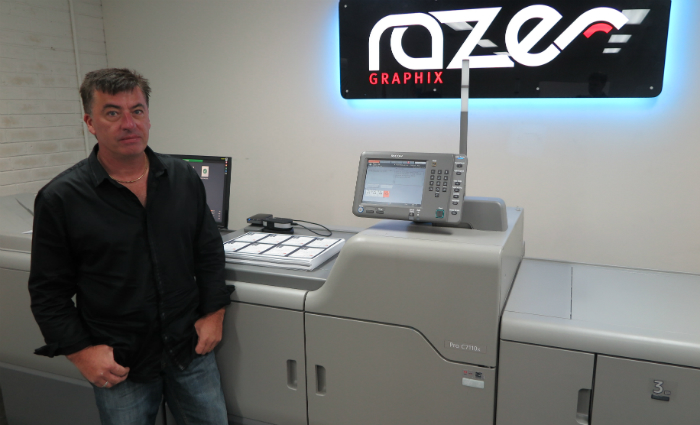
Melbourne trade printer Razer Graphix says it is opening new markets and delivering bigger profits since becoming the first business to install a Ricoh Pro C7110 digital production machine.
The business replaced half a dozen digital cutsheet printers with the new C7110 and a Ricoh C901, in search of better efficiency on short run work.
Managing director Alan Rye says Razer wanted to tap into the six-page A4 brochure market but needed a bigger sheet size than other printers supported. Speed was also a factor.
“A lot of our trade clients use us for runs of 200-300 which is too short for offset, and need them on a fast timetable,” he says.
“So we were looking for an engine that could duplex 350gsm, have a sheet size large enough to print a six page A4 brochure and the ability to print on textured stocks and synthetics.
“The C7110 ticked all the boxes and added a point of difference with a fifth colour station enabling clear and white toner.”
[Related: Kitted up]
Rye says offering white and clear toner puts Razer in a position to get involved in an emerging market that is increasingly popular, and gives him a value-add not many printers have.
“We are still finding work for that capability, but I think the work will appear once clients realise the benefits, and we will be able to offer a service few can,” he says.
He says the C7110’s clear toner capability will also set the company apart and allow it to add more value to a range of print work.
The new printer is also far more efficient than its predecessors at Razer, further improving the company’s bottom line with lower running costs and faster printing time.
Rye says the C7110 is so reliable and easy to use it has barely had any problems and less downtime allows him run more prints.
The machine was so easy for staff to use he even cancelled the training Ricoh offered until a paper jam after 185,000 prints. Then he had his staff trained.
Rye says as a newer machine the C7110 also has lower click charges. It will also have a longer lifespan, with Rye planning to replace it in three years after it has done 20 million impressions.
So far it has done 1.6 million as work flows in on the back of the new investment.
“The industry has changed since I started. For an operation like ours you need to have fast turnaround to provide just-in-time and on-demand printing and add value and margin where you can,” he says.
He says the combined efficiencies and being able to offer higher-value products means his margins are definitely higher but it is too early to tell by how much.
Despite his success, Rye says he wants to keep Razer small and profitable, rather than get bigger by chasing lower margin work.
Razer began as a print broker in 1993 but it was not long before Rye decided he wanted to be producing the print not just selling it.
He taught himself to use a monochrome Davidson offset press in 1995 and a few years later bought his first digital printer, and then a second in 2000.
Five years ago the company moved into its current facility, which it owns instead of leases, in the east Melbourne suburb of Bayswater.
Later he upgraded, with one digital printer producing six million impressions in two and a half years, and we already needed an upgrade. “That got me thinking about buying our new printers,” he says.
The digital colour printers C7110 and C901 are complemented by a fast output black and white printer, equipped with an inline saddle stitcher and trimmer.
Rye says Razer runs a five-staff, two shift operation and prides itself on being able to do everything in-house. It makes use of the latest in automation and employs lean manufacturing principles to keep overheads down.
“Once you outsource part of the process, you immediately lose control on both quality and delivery fronts which is not acceptable,” he says.
“When we promise our clients a quality product on time, we have to be in control of every part of the production process to ensure that we meet our commitment.”
To that end he has a full suite of finishing equipment, with two of every piece so he can crank out any kind of work to a tight deadline, including training manuals, binders, forms, and perfect bound book runs of up to 1000. It also does some warehousing for trade clients.
Comment below to have your say on this story.
If you have a news story or tip-off, get in touch at editorial@sprinter.com.au.
Sign up to the Sprinter newsletter
